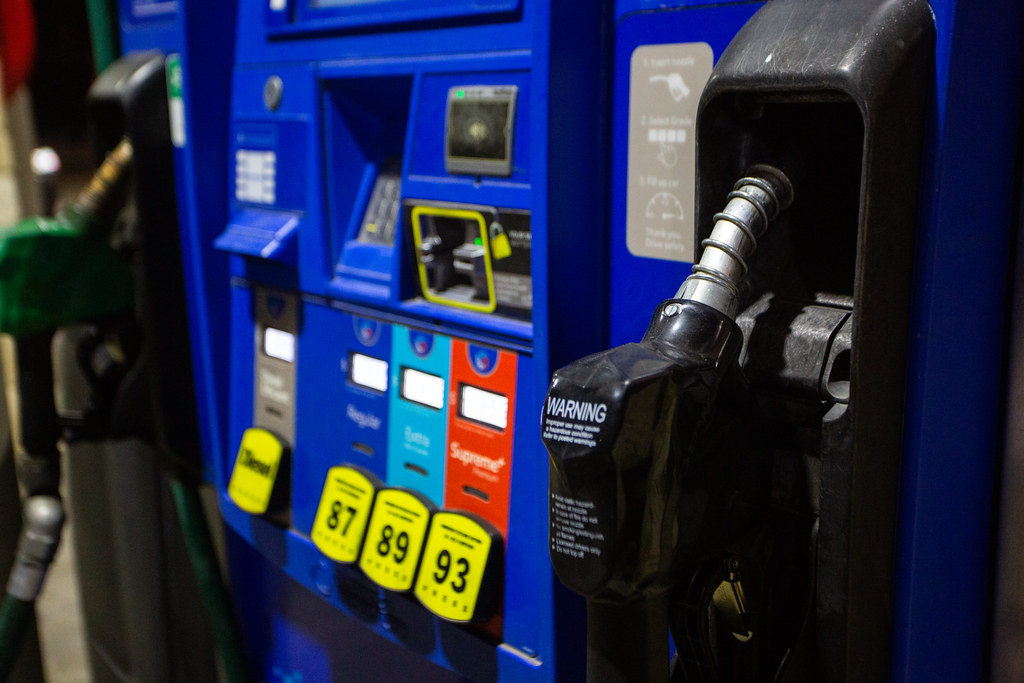If you’ve embarked on a summer road trip recently, you may have noticed that the cost to top off your tank has been quite a bit higher.
The average price per gallon in Texas is $3.46, up from $3.16 a month ago, according to AAA.
Matt Smith has been keeping an eye on the energy market moves as an analyst for Kpler and joined Texas Standard to share some insight on what’s driving the increase in prices.
This transcript has been edited lightly for clarity:
Texas Standard: What’s happening here with prices at the pump suddenly jumping? I mean, I wasn’t expecting summer to be a completely smooth ride, but $0.30 is still quite the price increase. What seem to be the key drivers behind this rising cost at the pump?
Matt Smith: It isn’t hurricanes, because hurricanes is one of those things that can pop prices, and, you know, we’re heading towards the peak of that.
But what has been the main driver here has been the rise in the oil price, that key input, essentially. And so oil prices have rallied about 20% over the last month or so – so that WTI, that U.S. benchmark, going from just under $70 to over $80. And the rule of thumb is that a $10 rise in the price of a barrel of oil equates to about $0.25 increase at the pump.
But another factor as well is refineries. So we’re passing through the peak of refining activity to meet that summer driving season, as you mentioned, that peak of demand there. But we’ve had some refinery outages; inventories are lower. Plus extremely high temperatures, which we all know about, right, have meant that refineries have been not able to run quite as hard just with the fear of things just breaking, essentially.
So the old supply/demand kicks in. We’ve got increased demand with summer travel, supply down at least in some part because of reduced refining capacity, right?
Yeah, that’s right – but prices compared to last year are actually lower. In Texas, the current average is around that $3.46 mark a gallon. That is up $0.30 versus last month, but it’s down $0.25 versus last year, because around the end of June of last year, that was when oil prices were peaking and that was when gasoline got pulled above that $5 a gallon national average.
So up versus last month, down versus last year. And that’s kind of across the board in the U.S.
» Texas Standard special report: An in-depth look at Texas gas stations – past, present and future
I don’t want to ask a dopey question here, but I think that the scenario you’re painting demands it: If oil prices are what’s driving up gasoline prices, well, what’s driving up oil prices?
Right. This is the key thing. So it’s predominantly been OPEC Plus, that group of countries that produce the majority of oil in the world –
Talking about Saudi Arabia and some of the Middle Eastern countries, plus Russia.
That’s right, and some African countries as well. And so the group has not only decided to cut production, but Saudi Arabia is making an additional voluntary cut of a million barrels per day to try and, you know, boost this oil price and take supply off the market. They’ve also managed to convince Russia to cut as well. So we’re seeing lower materially exports out of Russia, out of Saudi Arabia.
And so the combination of these two and the group generally are the key driver, why the markets are starting to tighten and get some positive sentiment here. So prices are on the rise.
» GET MORE NEWS FROM AROUND THE STATE: Sign up for our weekly ‘Talk of Texas’ newsletter
Is there any chance that we’ll see a rise in U.S. production that could offset some of those shortages? Or are we talking about a seasonal slowdown and, you know, some of the producers being concerned about their equipment?
Actually, it’s been really interesting because we’ve had lower prices this year. Production is not likely to rise unless we see prices sustained higher for a number of months. What we’ve been seeing, drilling activity continuing to slow hit. The oil rig count has dropped for eight straight months; it’s now at its lowest since March 2022.
And so operators have been hesitant to drill amid these lower prices and higher costs and also less of a focus to want to invest in the oil industry. So this combination of factors mean we’re not going to push to that record of 13 million barrels a day, at least for the foreseeable here through the end of the year.
















